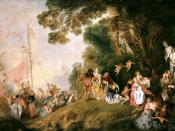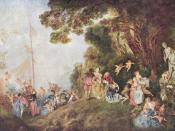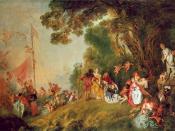Jean-Antoine Watteau (1684-1721) was a French Rococo artist. He was probably best known for his fetes galantes paintings, which depicted romanticized, idyllic scenes with elaborately costumed ladies and gentlemen at play, in fanciful outdoor settings. Many of his charming graceful paintings show his strong interest in theatre and ballet, an interest, which was possibly picked up while he studied with Claude Gillot who designed and executed scenery for the stage. Watteau was also heavily influenced by the work of Peter-Paul Rubens who he often 'borrowed' from in many of his works. In the years 1710-12 Watteau painted the first of three versions of the myth of Cythera, the island of love for which pilgrims embark but never arrive. His Pilgrimage to Cythera (fig. 1) served as his reception piece at the Academie Royale de Peinture. The painting I shall be referring to in this essay is the 1717 version, situated in the Louvre, Paris.
In this essay I aim to state what Félibien thinks are the criteria any painting must fulfill to become a good work of art, then to assess how far I think Watteau's 'Pilgrimage to Cythera' fulfills any of these criteria Félibien outlines.
The first point that Félibien makes is that the use of colour within a painting is extremely important. Félibien says that 'there should be a 'proper blending of colours and a correct rendering of light and shade so as to endow the whole canvas with an agreeable and appropriate variety' and it is in my view that Watteau does this. His colours are bright, delicate but also dark at the same time, being brighter on the left and darker on the right, which forms a pleasing contrast. The lighter left side of the painting really reflects the beauty of the landscape: the...


